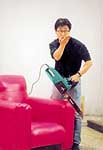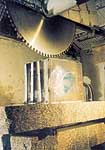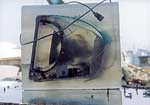|
The motor fires up and
a circular saw the size of a tractor wheel begins spinning
a few meters away from my nose. Dirty water sprays from
above onto the sharp serrated disk to keep it cool as
it is lowered down onto a brand new aqua-colored Apple
iMac. The iMac is encased in a block of transparent
polyester, and as the saw's teeth bite into the block,
the acrid smell of burning plastic fills my nostrils.
There is a ghastly grinding sound, and I imagine a chain
saw cutting into my own brain, spraying gristle and
grey matter in a pink cloud above my head.
Fortunately, I don't get close enough to the saw for
that to happen. Neither do the other spectators who
comprise three photographers, a video cameraman, five
bemused workers and the man responsible for this strange
experiment - Beijing-born artist Li Jiwei.

Li, 39, has invited
us to watch and record the vivisection of a US$1000
computer, in preparation for an exhibition entitled
Cut scheduled for display in Beijing this month. The
"cutting" edge artist is neither a Luddite, nor is he
a pawn in a Microsoft-sponsored offensive against Apple
computers. His brutal deconstruction of the iMac is
part of a video installation intended to explore issues
of life in an age of machines. Multimedia installation
art is a relatively new pursuit for Li, whose artistic
apprenticeship involved mastering the delicate brushwork
skill that traditional Chinese painters have pursued
for centuries. Born and raised in the capital, he graduated
from the Traditional Chinese Painting department of
Beijing's Central Academy of Fine Arts in 1984. As a
student his primary concern lay in the use of line in
shuimo (ink wash) paintings. This led organically to
an interest in abstract art, which he began to paint
in the late 1980s when he was teaching art at the Beijing
Film Academy. He left China in 1990 to obtain a masters
degree in abstract painting at the Academy of Fine Art
in Vienna, where he lived until 1998. Li has since moved
to Berlin, but he is back in Beijing this winter to
make and exhibit the installation work that includes
the sawn-up iMac. Cut is composed of five parts, each
one involving the dissection of an object. The actual
cutting up of the objects has been filmed; the completed
work includes both the objects and digitally-manipulated
video footage of the "operation."
The first work features a red lantern of the kind Chinese
restaurants often hang outside their doorways. The lantern
was coated in blood-red dye and then bisected using
an electric jigsaw. Li arranged sponsorship in Germany
from Osram, a company that manufactures lightbulbs.
Engineers at Osram's Berlin plant helped him cut a lightbulb
in half, taking care not to damage the filament, and
then resealed the bulb so that it could be illuminated.
The completed video footage shows the lantern being
sawn apart, exuding a gooey crimson liquid. The light
remains burning throughout the process. The two halves
split apart like a red, round flower opening up and
bleeding at the pain of birth.
Li's second operation was performed on a scarlet-colored
sofa. The artist used a chain saw to cut the common
item of household furniture in half, revealing rough
wooden boards, springs and foam padding beneath the
smooth surface of the vinyl.
A glass of water and Li's own body are the other bisected
objects. While he did actually cut the glass in half,
video trickery was used to both give the appearance
of cutting the water itself in two and to chop up his
body. These images are all striking, almost shocking.
But watching the iMac being sawn in half is a truly
cathartic experience, especially for a writer who spends
most of his days staring at the screen of exactly the
same model of computer. This is sweet revenge for daily
digital annoyances, hard drive crashes, and computer-induced
eye-strain and carpal tunnel syndrome. The slices of
iMac left after the operation have a strange, almost
organic beauty. They look like mollusks, fossilized
in the translucent, ice-like polyester.
The workers who helped Li saw up the computer felt differently
though. As they helped place the polyester-encased computer
on a big slab of stone and clamped it into place to
avoid any movement when the massive saw bit into it,
they chattered away in strong provincial accents about
their strange task.

"What kind of craziness
is this?" asks one. "What good can come from destroying
a computer worth more than I'll earn in two years?"
The difference between the way he saw the work and the
enthusiastic attitude of the photographers gathered
around is telling. Cut is about opposing halves and
opposites: rational thought embodied in a computer against
the illogical desire to make art; the digital revolution
symbolized by an iMac against the industrial revolution
symbolized by a motorized saw; the yin of the soft padded
sofa against the yang of the jigsaw blade; plastic against
steel; glass against water.
Li himself embodies many of these contradictions. He
is the quintessential cosmopolitan contemporary artist,
living in Berlin and working with the newest materials,
but his aesthetic sensibilities are grounded in ancient
Chinese traditions. His ink wash paintings of previous
experiments cutting-up computers reduce the 21st century
image of saw and sawn-up monitor to minimalist abstract
lines that have the feel and compositional elements
of traditional paintings. He has coffee for breakfast
and noodles for dinner; his speech switches from German
into Mandarin into German-inflected English; he drives
as though he is on the Autobahn even when he is on the
Third Ring Road.
Cut is likely to appeal to almost anyone who, like Li,
suffers the postmodern contradictions of exile, displacement
and being cut off from traditional roots. But even if
you think that only self-indulgent art critics suffer
from postmodern maladies, you should go see Cut, just
for the opportunity to see what an iMac looks like on
the inside.
Cut shows at China Art Archives & Warehouse, December
12-30. The exhibition opens at 2 pm, Sunday December
12.
Information:
Email: naac@public.gb.com.cn
Telephone: 6760-5364 / 130-0119-2709
URL: www.chinese-art.com/caaw.html
|





